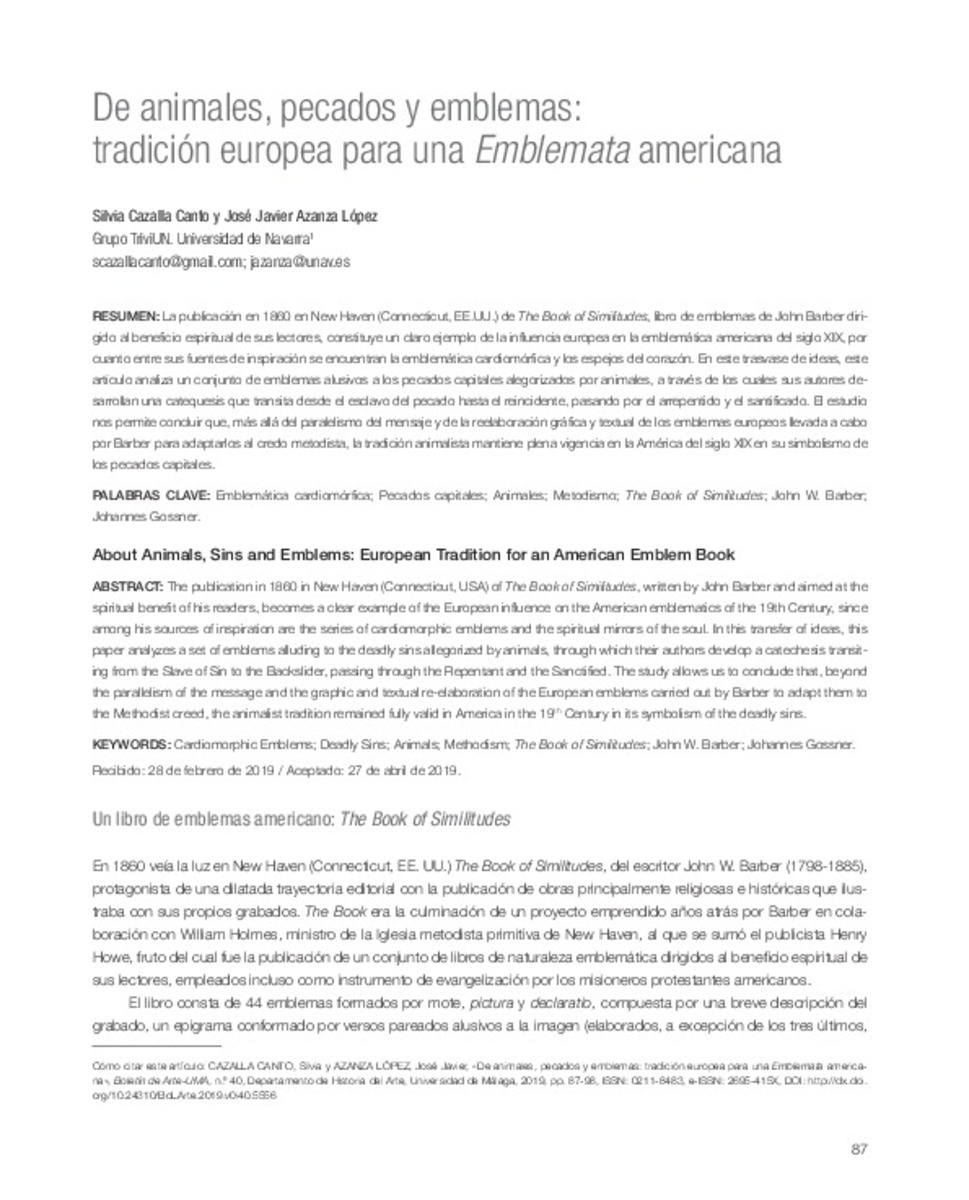Full metadata record
| DC Field | Value | Language |
|---|---|---|
| dc.creator | Cazalla-Canto, S. (Silvia) | - |
| dc.creator | Azanza-López, J.J. (José Javier) | - |
| dc.date.accessioned | 2020-11-19T13:40:20Z | - |
| dc.date.available | 2020-11-19T13:40:20Z | - |
| dc.date.issued | 2019 | - |
| dc.identifier.citation | Cazalla-Canto, S. (Silvia); Azanza-López, J.J. (José Javier). "De animales, pecados y emblemas: tradición europea para una Emblemata americana". Boletín de Arte. (40), 2019, 87 - 98 | es |
| dc.identifier.issn | 0211-8483 | - |
| dc.identifier.issn | 2695-415X | - |
| dc.identifier.uri | https://hdl.handle.net/10171/59736 | - |
| dc.description.abstract | La publicación en 1860 en new Haven (Connecticut, ee.UU.) de The Book of Similitudes, libro de emblemas de John Barber dirigido al beneficio espiritual de sus lectores, constituye un claro ejemplo de la influencia europea en la emblemática americana del siglo XIX, por cuanto entre sus fuentes de inspiración se encuentran la emblemática cardiomórfica y los espejos del corazón. En este trasvase de ideas, este artículo analiza un conjunto de emblemas alusivos a los pecados capitales alegorizados por animales, a través de los cuales sus autores desarrollan una catequesis que transita desde el esclavo del pecado hasta el reincidente, pasando por el arrepentido y el santificado. el estudio nos permite concluir que, más allá del paralelismo del mensaje y de la reelaboración gráfica y textual de los emblemas europeos llevada a cabo por Barber para adaptarlos al credo metodista, la tradición animalista mantiene plena vigencia en la américa del siglo XIX en su simbolismo de los pecados capitales. | es_ES |
| dc.description.abstract | The publication in 1860 in new Haven (Connecticut, USa) of The Book of Similitudes, written by John Barber and aimed at the spiritual benefit of his readers, becomes a clear example of the european influence on the american emblematics of the 19th Century, since among his sources of inspiration are the series of cardiomorphic emblems and the spiritual mirrors of the soul. In this transfer of ideas, this paper analyzes a set of emblems alluding to the deadly sins allegorized by animals, through which their authors develop a catechesis transiting from the Slave of Sin to the Backslider, passing through the Repentant and the Sanctified. the study allows us to conclude that, beyond the parallelism of the message and the graphic and textual re-elaboration of the european emblems carried out by Barber to adapt them to the Methodist creed, the animalist tradition remained fully valid in america in the 19 th Century in its symbolism of the deadly sins. | es_ES |
| dc.language.iso | spa | es_ES |
| dc.publisher | Departamento de Historia del Arte de la Universidad de Málaga | es_ES |
| dc.rights | info:eu-repo/semantics/openAccess | es_ES |
| dc.subject | Emblemática cardiomórfica | es_ES |
| dc.subject | Pecados capitales | es_ES |
| dc.subject | Animales | es_ES |
| dc.subject | Metodismo | es_ES |
| dc.subject | The Book of Similitudes | es_ES |
| dc.subject | John W. Barber | es_ES |
| dc.subject | Johannes Gossner | es_ES |
| dc.subject | Cardiomorphic emblems | es_ES |
| dc.subject | Deadly Sins | es_ES |
| dc.subject | Animals | es_ES |
| dc.subject | Methodism | es_ES |
| dc.title | De animales, pecados y emblemas: tradición europea para una Emblemata americana | es_ES |
| dc.title.alternative | About animals, sins and emblems: european Tradition for an american emblem book | es_ES |
| dc.type | info:eu-repo/semantics/article | es_ES |
| dc.publisher.place | Málaga | es_ES |
| dc.description.note | Esta obra está bajo licencia internacional Creative Commons Reconocimiento-NoComercial-CompartirIgual 4.0. | es_ES |
| dadun.citation.endingPage | 98 | es_ES |
| dadun.citation.number | 40 | es_ES |
| dadun.citation.publicationName | Boletín de Arte | es_ES |
| dadun.citation.startingPage | 87 | es_ES |
Files in This Item:
Statistics and impact
Items in Dadun are protected by copyright, with all rights reserved, unless otherwise indicated.






